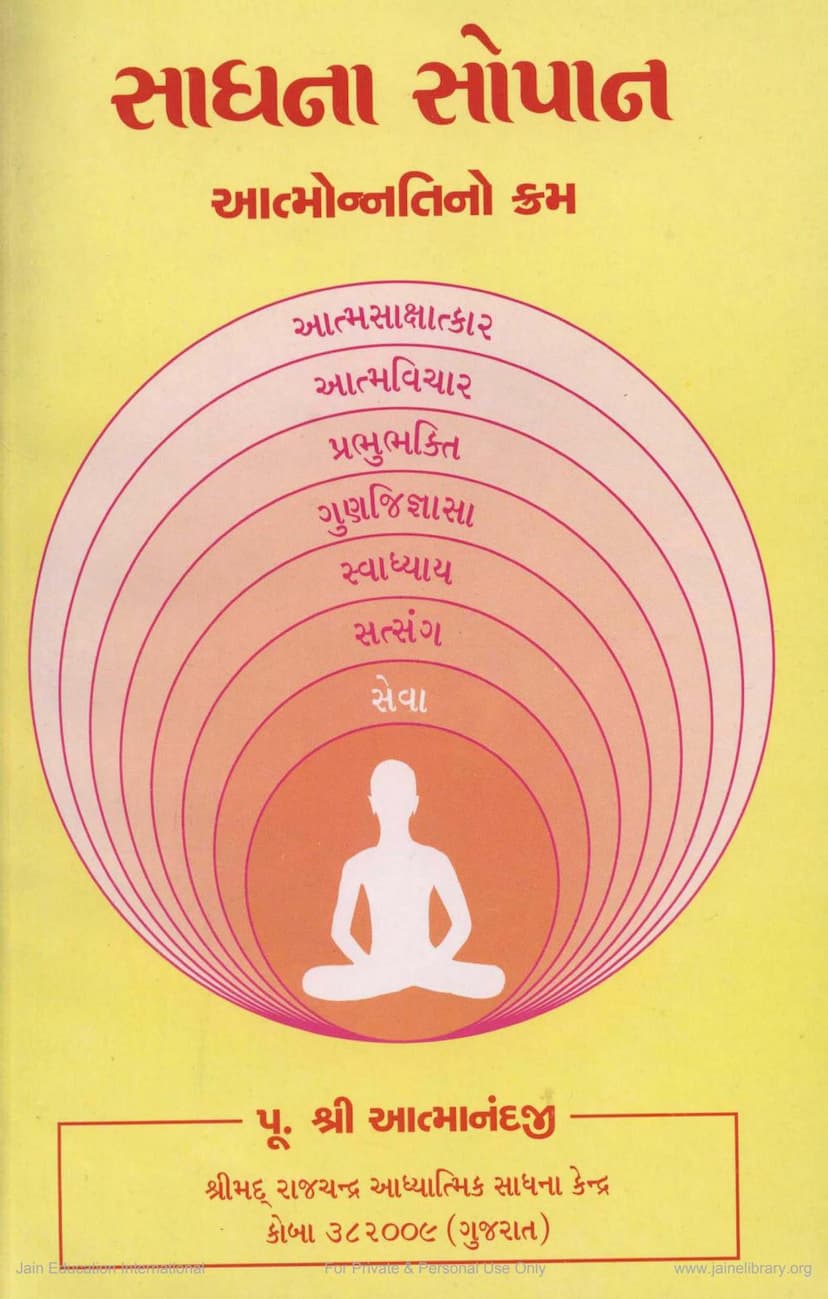Sadhna Sopan
Added to library: September 2, 2025

Summary
Here's a comprehensive summary of the Jain text "Sadhna Sopan" by Atmanandji Maharaj:
"Sadhna Sopan" (The Ladder of Spiritual Practice) by Param Shraddhey Shri Atmanandji Maharaj is a profound Jain text that outlines a systematic, step-by-step approach to spiritual progress and self-realization. The book is published by Shri Satkrut-Seva-Sadhana Kendra (Shrimad Rajchandra Adhyatmik Sadhana Kendra) in Koba, Gujarat.
Core Philosophy and Structure:
The book is structured as a "ladder" (Sopan), implying a progressive ascent towards the ultimate goal of spiritual upliftment (Atmonnati) and self-realization (Atmasakshatkar). It emphasizes that true spiritual progress is achieved through a consistent and dedicated practice of various spiritual disciplines. The text is divided into five chapters, each representing a crucial rung on this ladder:
-
Satsang (Company of the Virtuous): This chapter highlights the paramount importance of associating with spiritually elevated beings, scriptures, and like-minded seekers. It explains that true Satsang is not merely physical proximity but the cultivation of a mindset that leads to spiritual purification and inspiration. It details the various forms of Satsang, from listening to the words of saints to the company of virtuous individuals. The chapter stresses the need for regular engagement with Satsang to maintain spiritual awareness and derive its benefits.
-
Swadhyaya (Self-Study/Study of Scriptures): This section focuses on the systematic study and contemplation of spiritual texts. It emphasizes the importance of understanding the true nature of reality, distinguishing between what should be avoided (Hea) and what should be embraced (Upadeya). Swadhyaya is presented as a crucial tool for gaining right knowledge, which is the foundation for right faith and right conduct. The chapter guides the seeker on how to select scriptures, the importance of regular reading, writing down insights, and the transformative power of contemplative study.
-
Gunajignasa (Inquiry into Virtues): This chapter delves into the cultivation of virtuous qualities, which are essential for spiritual progress. It stresses the need for self-awareness, acknowledging one's own faults and shortcomings, and then actively striving to develop positive qualities. The text outlines a progression from basic human virtues (humanity, good conduct in society) to more specific spiritual virtues. It highlights the importance of humility, non-violence, truthfulness, contentment, self-discipline, devotion to God, compassion, patience, and equanimity. The chapter also emphasizes the role of sincere spiritual desire (Mumukshutva) and the importance of associating with those who embody these virtues.
-
Prabhubhakti (Devotion to the Divine): This section explores the path of devotion as a powerful means to spiritual growth. It explains that devotion is not merely outward ritual but a deep, loving connection with the Divine. The text describes various forms of devotion, including listening (Shravana), chanting (Kirtan), contemplation (Chintavan), salutation (Vandan), service (Sevan), meditation (Dhyan), humility (Lagutta), equanimity (Samata), and oneness (Ekta). It emphasizes that consistent and heartfelt devotion purifies the mind, fosters detachment from worldly desires, and ultimately leads to a deep communion with the Divine.
-
Atm Vichar - Atma Sakshatkar (Self-Inquiry - Self-Realization): This is the culminating chapter, focusing on the practice of deep contemplation, meditation, and self-inquiry to achieve self-realization. It highlights the prerequisites for effective meditation, such as a clear understanding of the ultimate goal, a disciplined and pure lifestyle, mindful eating, managing social relationships, and practicing celibacy where appropriate. The chapter details various meditation techniques, including focusing on divine forms, mantras, breath, and the inner light. It describes the subtle experiences that may arise during meditation and ultimately leads to the realization of the true self – the soul, which is inherently pure, conscious, and blissful. The text explains that through sustained practice, the seeker transcends the limitations of the body and mind, experiencing a state of profound peace, equanimity, and oneness with the Divine.
Key Principles and Themes:
- Systematic Approach: The book presents a clear, progressive path, emphasizing that spiritual growth is not achieved through mere intellectual understanding but through consistent practice.
- Holistic Development: "Sadhna Sopan" advocates for a balanced approach, integrating virtuous conduct, scriptural study, devotion, and meditation.
- Role of the Guru: The text implicitly and explicitly highlights the importance of a spiritual guide (Guru) or enlightened master in navigating the path of self-realization.
- Inner Transformation: The ultimate aim is not external ritual but inner purification and the realization of one's true, divine nature.
- Practical Guidance: The book offers practical advice on managing daily life, time, and inclinations to facilitate spiritual practice.
- Jain Ethical Framework: While not explicitly limited to Jainism, the principles espoused are deeply rooted in Jain philosophy, emphasizing ahimsa (non-violence), truth, non-possession, and self-control.
In essence, "Sadhna Sopan" serves as a comprehensive guide for anyone seeking to embark on a sincere spiritual journey, providing them with the tools, understanding, and inspiration to ascend the ladder of self-realization. It emphasizes that by diligently following these steps, one can overcome spiritual obstacles, cultivate inner virtues, and ultimately achieve the highest spiritual attainment.